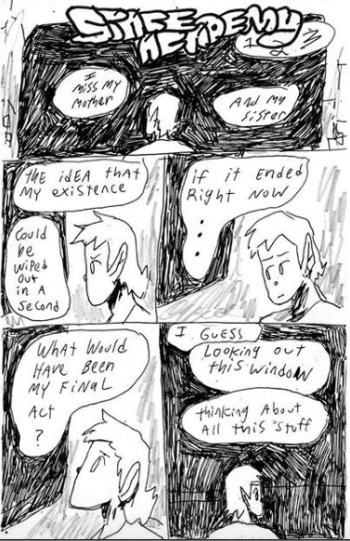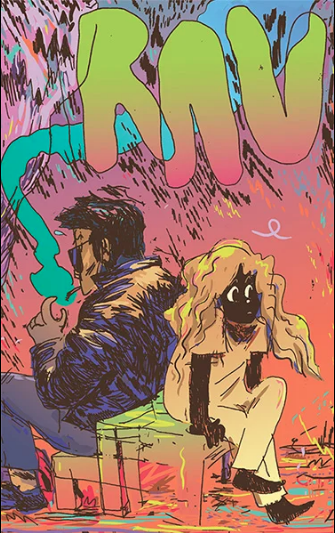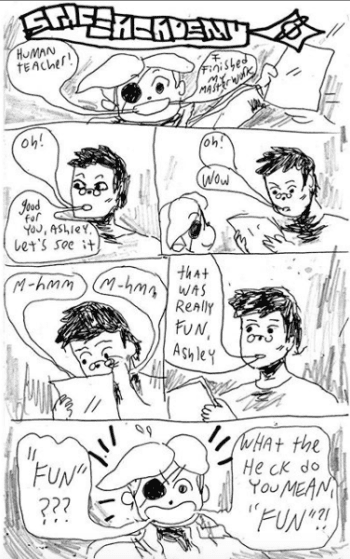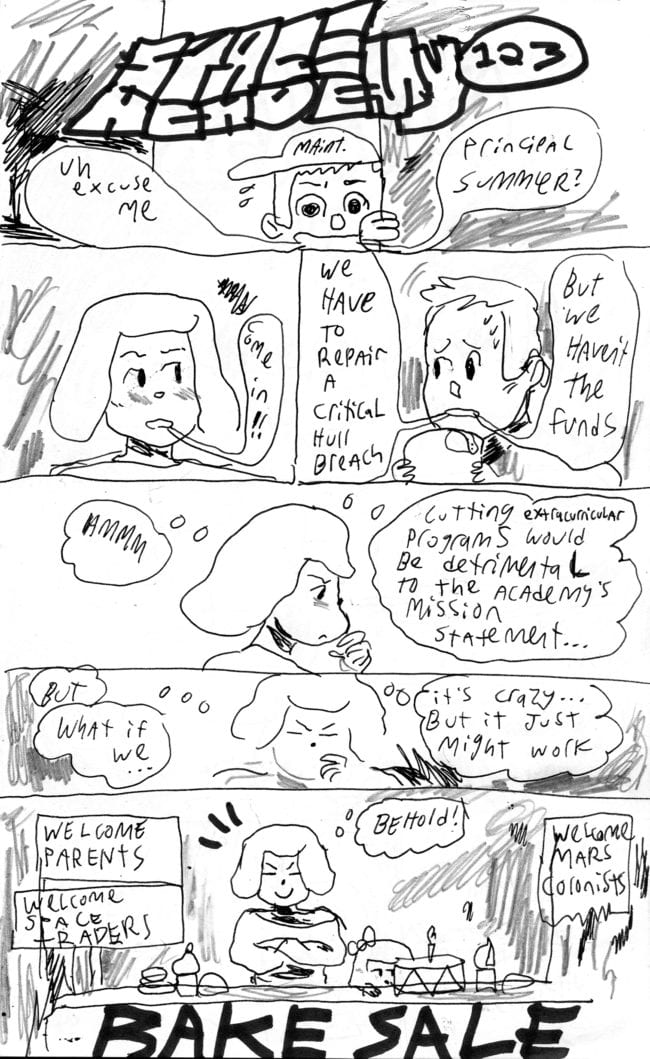Mickey Zacchilli, or Mickey Z. as she is often credited, lives in a cold house with a wood-burning heater and a couple of cats, including the playfully named Hamburger. Her bio on the Koyama Press website states, “She is a massage therapist and a purple belt in Brazilian jiu-jitsu.” Mickey was kind enough to let me and her Lovers Only cohort Sophia Foster-Dimino stay there during the Rhode Island Print Expo way back, and the DIY-run place seemed to me to be wrapped up in a punk romanticism, a feeling that her comics embrace. Her magnum opus is the ongoing RAV series, a sprawling but intimate love story serial that has earned comparisons to Joyce, due to its structural innovations and epic qualities. She contributed to and began the Lovers Only comics, a continuing floppy anthology that also has featured Cathy G. Johnson, Sophia, and Carta Monir; Youth in Decline publishes both the RAV book collections and Lovers Only. Her most recent book is Space Academy 123 from Koyama Press, a story that follows what appears to be an interstellar high school run by the mysterious and suspect Grandfather Computer. Mickey, who produces comics at a stunning pace on typing paper, also creates things like the ever-popular Cool Dog stickers seen all over. She has influenced artists like her contemporary Michael DeForge. The English cartoonist Robin William Scott said in a common sentiment about Mickey’s Venom minicomic, “It made me realize how obsessed with a very stuffy precision I was in my own work, and how stifling that had become. Her vibrant, explosive, frenetic, kinetic, style made me want break every rule I’d written for myself without realizing it.” I spoke to Mickey by email.
ANNIE MOK: Space Academy 123 struck me as more immediately accessible than RAV, simply because it’s less visually dense. Both approaches, of course, have their own merits. When I first read RAV, I found myself having to take a moment to adjust myself to work my way into its world, but with the more aesthetically open SA123, I dropped right in. How do readers’ potential reactions figure into your working methods, if they do come into play?
MICKEY ZACCHILLI: I think RAV's inaccessibility was mostly due to me being a less experienced, more excited cartoonist... I made the first RAV zine ten years ago! I didn't perceive it as inaccessible when I made it, but then people kept telling me they had a hard time reading it, or couldn't read it at all. I remember sometimes being annoyed, because I really couldn't understand how people couldn't read it! I didn't adjust my work to the criticism, at least not consciously, but RAV did become easier to read over time (at least, I think it did??). SA123's visual accessibility also wasn't intentional. Again I think that change is mostly about experience and other stuff (such as uh, laziness). But, I am glad people have an easier time reading it than they did with RAV!
SA123 began life as a serialized webcomic, one page going up a time. Similarly, you self-publish RAV in minicomics before Youth in Decline collects them into thick paperbacks. What does serialization bring to your work that you might not get if you sat down and worked on a standalone graphic novel that comes out all in one shot?
I started making RAV because I wanted to see if I could make a big, long epic... but sitting down and planning it all out sounded really boring. So I thought I'd just start and see where it went! Serializing it seemed like the best way to motivate me to continue... Have you heard that thing about, if you are feeling overwhelmed, it's best to break everything you have to do into small little parts? Much less daunting! Plus, the work tends to evolve over time in a way that I don't think it would if I was drawing something big with no breaks in between. There's more time to process ideas with breaks in between. RAV started out as one thing, with my intention, and then kind of became its own thing separate from me. I think SA123 did also. It also feels good to be able to show people what you're working on, and it's nice when someone says they like it or have an opinion about it! Honestly I don't think I'd be able to sit down and draw a big graphic novel, that's not how my brain likes to work.
SA123, being a collected SF/F webcomic about high schoolers, reminded me of Jillian Tamaki’s SuperMutant Magic Academy. Both stories made me laugh with humor at times light, and at others cutting; both use the high school setting to pose questions about the nature of authority; and both treat their group of young protagonists with tremendous empathy. What thinking processes went behind your development of your characters here and their developing approaches to life? Do you intend for SA123 and some of your other work like Lovers Only to be read by young people?
Yeah! I love SMMA, honestly I think it's a masterpiece, and it is definitely a huge influence for SA123. The stuff she chooses to write about always really resonates with me and I do like how she is empathetic with her characters, like you say! I'd always wanted to draw a high school comic since CF's Monorail High (also an incredible comic, serialized in Mothers News). I have trouble writing narrative-driven stories, I'm more interested in the characters and how they interact with each other and the world, and how they're doing themselves-- the narrative is an afterthought. I don't consciously develop characters, they kind of develop on their own? I think maybe that's why they seem to be treated with empathy, because they (this is cheesy as hell but) come alive, and then I can't help but treat them with empathy haha. Also I just like reading character driven stuff, more and more it's hard for me to read about people getting hurt or being stuck in upsetting situations, or with cruel people, and I tend to write things i'd want to read myself. I've written bad people into my stories but, the bad people are always still empathetic, they just maybe exploit it or something; like Ben, in RAV.
Also, when I started doing SA123, I had pretty recently gone back to school, and it was pretty intense being put back into a context like that at 32 years old, wearing a uniform and obeying your teachers, having to ask permission to go to the bathroom or get a coffee, having to get a nice business outfit for career day, and not really feeling comfortable or relaxed being yourself. So, I was definitely in a place mentally to write about high school hahaha. When I got out and started working again, the story shifted to be more about Donna and her work life.
Sorry, rereading the above it's a pretty disjointed series of paragraphs!
 I think a lot of burgeoning cartoonists see you as something of an artistic hero. Have you seen or heard about your influence on other cartoonists and their work? Are there artists you, in turn, have work you’ve been influenced by?
I think a lot of burgeoning cartoonists see you as something of an artistic hero. Have you seen or heard about your influence on other cartoonists and their work? Are there artists you, in turn, have work you’ve been influenced by?
Uhhh I haven't heard this, about me being an artistic hero haha. There are a lot of artists and works I'm influenced by, of course! Jillian Tamaki and CF, as I mentioned above. Brian Chippendale has certainly been an influence on me but please don't ever talk to me about Fort Thunder. I'm always inspired by Michael DeForge (SA123 wouldn't exist were it not for Leaving Richard's Valley, which was Michael's daily Instagram comic that inspired me to start my own) and lately I've been reading the Naruto manga which has been really inspiring, for like, life in general haha, also watching Avatar: The Last Airbender (about to start Legend of Korra) which has been similarly inspiring and energizing in lots of ways. It feels stressful to make a list of people who inspire me right now because I'm really bad at recalling things off the top of my head and might forget to include a person that is particularly inspiring to me or something!!! So i'm not gonna do that. But there are so many amazing cartoonists working today! I feel inspired just thinking about reading comics. I just really like comics right now I guess!
One of your signatures is speech balloons with the tails connecting right to the speakers’ mouths, and hand-lettering with a lot of flair and personality. The decision, of course, makes no more or less sense than any other of the visual languages comics has developed over the last century, but it’s striking. When I read your comics, this touch makes me think about how the characters are communicating, how they may sound when they talk, in a way I may not get from more traditional speech balloons and lettering. How did you come to these approaches to balloons and letters?
I started doing the word bubbles that way because I used to not be so good at anticipating the layout, so I would just have to squeeze the bubbles in wherever, and sometimes it would be really confusing as to who was speaking if the bubble didn't connect directly to their mouth haha. So, it came about out of necessity. I still do it because I think it's way easier to understand that way, and it always felt kind of weird to me that the word bubbles are often added after the drawing is done, just overlaying the drawing, like they aren't an integral part of the comic?
Also I found I could break up the bubbles (sometimes a character will have two or three bubbles coming out of his mouth in the same panel) which allowed me to control the pacing of the speech -- so I was able to deliver it to the reader in a more specific manner, like in a movie! Hope that makes sense. I guess you can do that with regular word bubbles too!
What are your drawing methods like? Do you do a layer of underdrawing, or thumbnailing, or any sort of preparation for the finished page? The pages seem at least somewhat improvised to me, but as with free jazz or any sort of art with a lot of seeming spontaneity, there may of course be much preparation behind it. Can you talk a bit about your day-to-day process and the materials you use?
I don't do an underdrawing or thumbnail. For both RAV and SA123 I drew directly onto the page with a uni-ball Vision micro pen, in a 5 x 8.25-inch notebook. I also used a pencil for SA123 because it was an easy way to add a gray tone. Previously for RAV, I would scan the page and add digital halftone dots, which was tedious and I don't think I will do that anymore. I don't like spending more time than I have to on something, and I think that is strongly reflected in the way I draw haha (especially lately). I also like to get right down to business, and for me thumbnailing or sketching something before inking it isn't going to make it look better, it's just going to make me lose interest in it and never finish. The more time you spend on something, the more precious it becomes. I can't handle that kind of pressure! Also regarding materials, recently I got a Surface Pro tablet to draw right on the screen for the purpose of removing the task of scanning and editing, but I can't tell if this approach is going to work for me or not!
 In SA123, the character Ashley Forgiveness thinks at one point, “Can’t believe I was cast as a girly girl. I’ve always thought of myself as more of a swashbuckling Mercutio type than a maiden fair.” What’s the process like for you of developing characters who are young queer kids maybe dealing with gender issues, with empathy, as you said before?
In SA123, the character Ashley Forgiveness thinks at one point, “Can’t believe I was cast as a girly girl. I’ve always thought of myself as more of a swashbuckling Mercutio type than a maiden fair.” What’s the process like for you of developing characters who are young queer kids maybe dealing with gender issues, with empathy, as you said before?
I think a lot of that particular process comes in part from personal experience and in part how I would ideally like things to be, or liked them to have been... for me, personally. In the comic you mention above, Ashley expresses what's true for her, that she feels more swashbuckling-- but is also not opposed to trying something else for fun, for the play. Later, she even confidently wears a wig, and a dress. Nobody except her really acknowledges it. In this world, Ashley is free to be flexible with her gender without receiving a lot of (what I would perceive as) unwanted attention from other people. I've always dressed more masc I guess, and I hated dressing fem as a kid mostly because everyone gives you a really hard time about wearing a dress when you don't usually wear one! I feel like I was a little bit pigeonholed as a tomboy, which made it really hard for me to experiment with being any other way. I sometimes like dressing fem now, for weddings and stuff, because nobody close to me gives me a hard time. I just wonder what it would have been like growing up if nobody gave anybody a hard time for not dressing the same way everyday. Is that response too specific? haha
SA123’s Grandfather Computer character deals directly with a topic I see as one of your central artistic concerns here, which is capitalism and the idea of bosses. Interestingly, you even perhaps show some empathy for Grandfather Computer at times and the situation he finds himself in. Can you talk a bit on how conversations around capitalism filters into your comics through Grandfather Computer and perhaps other ways too?
Yeah, I think with SA123 I thought a lot about capitalism as being a massive trap that everybody is just stuck in, because everyone has to make money to survive so, you have to participate somehow and I was basically doing just that at the time; in school, wearing a uniform, all so I could get a job-- and then halfway through SA123 I was out of school, working my new job. So, it was on my mind a lot. But like those memes say, "there's no ethical consumption under capitalism" because any participation just keeps the wheels turning, among other things, and there's no way to stop it (it seems! without massive restructuring anyway). You can kind of like... float above the feeling of capitalism if you have a lot of money or privilege but most everyone is just in it. It's unfortunately extremely universal haha. More specifically, I think a lot about how when you're in it, even if you're a good person, sometimes you can't make the decision you feel is right because there are all these obstructions forcing you (either below the surface or outright) to maintain the status quo--- such as a boss, company rules, risk of losing your job, racism, sexism, homophobia, transphobia, etc. That's a really complex and fucked up system working to keep things as they are, keeping people from standing up for what's right without suffering massive losses, some more than others. Donna has to make some decisions that go against her moral compass in SA123 because of pressure from Grandfather Computer as well as her relative inexperience in the workforce, she is definitely a character who feels trapped within her position, but is slowly learning how to deal with it. Shandy, too!
Ashley Forgiveness says at one point, “This dang dress, it’s so itchy! Why did people wear itchy things in the olden days?? To be beautiful?? Why bother! When you can be beautiful…. In a trash bag!” To me, this is a lovely statement. Do you intend to make beautiful objects when you work? What does the concept of beauty spark for you, as per Forgiveness’s ideas?
I try to make work I like, and work that feels "nice" to me, I think... and anything can be beautiful. It's a matter of perspective sometimes, sometimes it feels obvious, I don't know if I think of my work as beautiful. I think Ashley was expressing the ease with which one can be beautiful, not to say a dress isn't beautiful, but how it feels to wear it (itchy) is an unnecessary discomfort, when you could be or feel beautiful doing something much less uncomfortable, easier--- but also less traditionally beautiful (trash bag) or straight up harsh (polluted ocean). I do like my work to feel easy. If it feels hard to me.... that means I'm taking the wrong approach (for me), and should try again later, or figure out another way. Ultimately, I don't like things to be hard, and there's no reason I should be making comics hard for myself. I'm just having fun! It's possible that as a result of my fun-loving attitude my work is not as tight or nice to look at as some other people's work!
 Finally, again, Ashley Forgiveness at one point hands in her “masterwork” to a teacher, who says, “That was really fun, Ashley.” Ashley gets annoyed and says, “‘Fun’! What the heck do you mean, ‘Fun’?!” After Ashley’s outburst, the teacher says, “B-b-but Ashley… don’t you love fun?” And she says, wistfully, with shojo manga style stars and flowers around her, “It’s true, I love fun.” Once again, this seems emblematic of your work: the comics just bust with fun and life. It reminds me of Lynda Barry’s concept of play being very important for humans, especially young people. Is fun something you pursue when you make comics?
Finally, again, Ashley Forgiveness at one point hands in her “masterwork” to a teacher, who says, “That was really fun, Ashley.” Ashley gets annoyed and says, “‘Fun’! What the heck do you mean, ‘Fun’?!” After Ashley’s outburst, the teacher says, “B-b-but Ashley… don’t you love fun?” And she says, wistfully, with shojo manga style stars and flowers around her, “It’s true, I love fun.” Once again, this seems emblematic of your work: the comics just bust with fun and life. It reminds me of Lynda Barry’s concept of play being very important for humans, especially young people. Is fun something you pursue when you make comics?
Yeah! Like I said in my response to the last question, I'm just having fun, just trying to have fun with it... if I'm not having fun drawing comics, why am I drawing comics? I used to think I wanted to be a career cartoonist, or something, but everything connected to that made it not very fun, and stressful, and I'd make work just because I felt like I had to, I'd make work for all the wrong reasons, or when I didn't feel like making work, which made everything very not fun and it didn't make me happy. I think this ties into the whole capitalism thing we talked about before, because ultimately, I went back to school so I could make money doing something else that wasn't comics or art stuff, and am now kind of reevaluating what I want to do, what is fun for me vs. what I've always done automatically because I felt like I should, for whatever reason (in regards to comics and art stuff). Fun is what I pursue when I make comics, absolutely, and I think fun is what I hope for in my regular life, fun and happiness, but like.... it's definitely, absolutely not always like that unfortunately hahaha. But it's a goal. My friend Al always talks about fun, and how having fun is her priority, and although that concept has always been true for me, I feel like Al really sums it up when she says "I love fun" --- Ashley's love of fun is definitely based on that nice sentiment.







